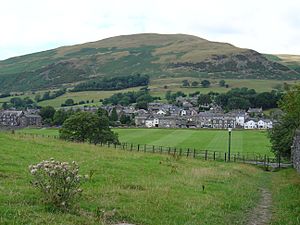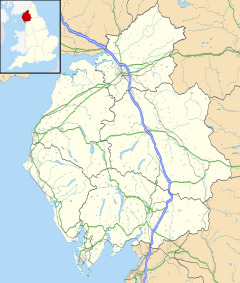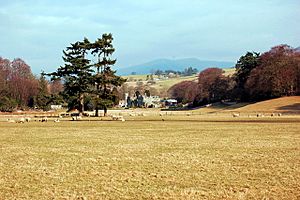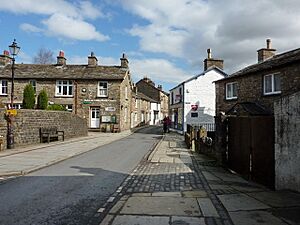Sedbergh facts for kids
Quick facts for kids Sedbergh |
|
|---|---|
 |
|
| Population | 2,765 (2011) |
| OS grid reference | SD6592 |
| Civil parish |
|
| Unitary authority |
|
| Ceremonial county | |
| Region | |
| Country | England |
| Sovereign state | United Kingdom |
| Post town | SEDBERGH |
| Postcode district | LA10 |
| Dialling code | 015396 |
| Police | Cumbria |
| Fire | Cumbria |
| Ambulance | North West |
| EU Parliament | North West England |
| UK Parliament |
|
Sedbergh (pronounced SED-ber) is a small town in the county of Cumbria, England. It is also a "civil parish," which is a local area with its own council. Historically, Sedbergh was part of Yorkshire. Since April 2023, it has been managed by the Westmorland and Furness local government.
In 2011, about 2,765 people lived in Sedbergh. The town is located about 10 miles (16 km) east of Kendal. It is also about 28 miles (45 km) north of Lancaster and 10 miles (16 km) north of Kirkby Lonsdale. Sedbergh is inside the Yorkshire Dales National Park. It sits at the bottom of the Howgill Fells hills. The River Rawthey flows past the town and later joins the River Lune.
Contents
Exploring Sedbergh
Sedbergh has a main street with many shops. From almost anywhere in town, you can see the tall hills around it. In the past, before trains arrived in 1861, it was hard to reach Sedbergh. People had to walk over steep hills to get there. Trains used to run through Sedbergh railway station from 1861 to 1954.
The Sedbergh area is quite large. It includes small villages like Millthrop, Catholes, and Howgill. It also covers parts of the Howgill Fells and Baugh Fell.
Famous Visitors
George Fox, who helped start the Religious Society of Friends (also known as Quakers), visited Sedbergh in 1652. He spoke in the churchyard of St Andrew's Church. He also spoke on nearby Firbank Fell. The Briggflatts Meeting House, a Quaker building, was built in 1675. It is famous because a long poem called Briggflatts (1966) was named after it.
Schools in Sedbergh
Sedbergh has three schools. Sedbergh Primary School is the main public primary school. Settlebeck School is the main public secondary school. There is also Sedbergh School, which is a private boarding school for both boys and girls.
Sedbergh's Past
Sedbergh's main church, St Andrew's Church, was built in the 1100s. It has been repaired many times since then. Some houses in the town are even older, dating back to the 1300s. There are also remains of an old motte and bailey castle. People believe this castle was built during Saxon times.
For a long time, Sedbergh's main jobs were farming and making wool clothes. Wool was sent to mills to be spun into yarn. Then, people at home would knit things like hats and socks. These items were sold to people like coal miners in North-East England. You can learn about this history at Farfield Mill, just outside town. It has old weaving machines and workshops where artists now work.
How Sedbergh is Governed
Sedbergh is part of the Westmorland and Lonsdale area for national elections. Tim Farron from the Liberal Democrats is the current Member of Parliament for this area.
Locally, Sedbergh is part of the Sedbergh and Kirkby Lonsdale area. This area is managed by the Westmorland and Furness Council. Sedbergh also has its own local group called a parish council.
What Sedbergh Offers
People in Sedbergh earn money from different jobs. The schools are big employers. Sedbergh is also England's official book town. This means it has many independent bookshops. It is smaller than other book towns like Hay-on-Wye in Wales.
Many people also work in small manufacturing and wholesale companies. Farming, shops, and tourism are also important for the town's economy. Sedbergh became more well-known after a BBC TV show called The Town that Wants a Twin in 2005. Because of this show, Sedbergh became "twinned" with Zreče in Slovenia.
In 2001, the town had an outbreak of foot-and-mouth disease, which affected farm animals. As farming became less common, Sedbergh became a popular place for walkers. In 2015, it was named a "Walkers are Welcome" town.
Sedbergh has a golf club located at Catholes-Abbott Holme. A monthly booklet called "Sedbergh and District Lookaround" shares local events and activities.
News and Media
Local news and TV shows for Sedbergh come from BBC North West and ITV Border. You can get TV signals from local transmitters in Sedbergh and Millthrop.
Radio stations like BBC Radio Lancashire and BBC Radio Cumbria serve the town. Other stations include Heart North West and Greatest Hits Radio Cumbria & South West Scotland. There is also Dales Radio, which is a local community station.
The local newspaper that covers Sedbergh is The Westmorland Gazette.
Important Landmarks
Ingmire Hall is about 2 miles (3 km) west of Sedbergh. It was mostly built in the 1500s and includes an old pele tower. The house was made bigger in the Victorian era and again in the 1900s. A fire in the 1920s caused a lot of damage, but it was fixed in the 1980s. The hall is privately owned, but a public path goes along its driveway.
St Gregory's Church is an old Anglican church. It is located about 1.5 miles (2.4 km) west of Sedbergh on the A684 road. This church is a "Grade II listed building," which means it is an important historic building. It is now looked after by the Churches Conservation Trust.
The Cross Keys Temperance Inn is a pub that is 400 years old. It is now run by the National Trust.
Twin Town
Sedbergh has been "twinned" with Zreče, Slovenia, since 2005. This means the towns have a special friendship and often share culture.
See also
In Spanish: Sedbergh para niños




